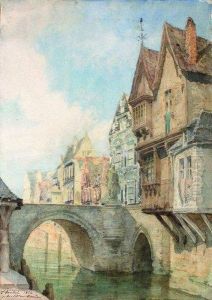Jules Pierre M. Dieterle Paintings
Jules Pierre M. Dieterle was a French artist born in 1821, whose work primarily focused on genre painting, landscapes, and historical scenes. Dieterle's career spanned much of the 19th century, a period marked by significant changes in the arts in France, including the rise of Romanticism, Realism, and Impressionism.
There is limited information available on Dieterle’s early life, but it is known that he was active during a time when Paris was the epicenter of the art world. Like many artists of his day, Dieterle would have been influenced by the shifting artistic movements and the tumultuous political climate of 19th-century France.
Dieterle's work was reflective of the era's interest in depicting scenes of everyday life, historical events, and the natural world with a sense of realism and attention to detail. However, he did not gain the same level of fame as some of his contemporaries, such as Gustave Courbet or Édouard Manet, who are well-known for their contributions to Realism and Impressionism, respectively.
Despite this, Dieterle was a competent artist who contributed to the rich tapestry of French art in the 19th century. His paintings may have been exhibited in salons, which were the primary venue for artists to showcase their work to the public and potential patrons. The Salon, an annual or biennial exhibition held in Paris, was the most prestigious art event in the Western world at the time.
Jules Pierre M. Dieterle passed away in 1916, leaving behind a legacy of artwork that captured the essence of his time. While he may not be a household name, his contributions to the arts during a period of great change and innovation provide valuable insight into the lesser-known artists of the era and the breadth of talent that existed alongside the great masters of 19th-century French art.
